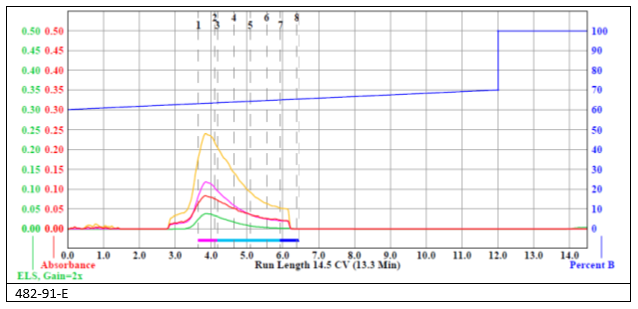
As chemists we are fortunate that automated flash purification is so forgiving. The gradient nature of running the common hexane/ethyl acetate solvent system from 0 to 100% gives us many first-time successes. This resilience is driven by the inherent retention change as the gradient progresses to higher solvent strength (%B of our first-choice solvent system); this is the same reason driving the calculation and success of focused gradients (as we have previously discussed). Sometimes though relying on the changing %B solvent strength isn't sufficient to offer resolution of certain compounds.
For example, one of our sister divisions needed us to purify a porphyrin for an opto-electronic project. Our first attempts using ethyl acetate/hexane failed to result in separation. Likewise, hexane/dichloromethane didn't run well either, exhibiting tailing. When our go-to default methods don't yield success, taking a step back and analyzing the properties of the compound being purified can guide us to choose an alternative solvent systems (or stationary phase, but that is a topic for a later date) that may result in better retention and separation.
The unique property of porphyrins is that they are aromatic. So using an aromatic eluting solvent like toluene works well due to pi-pi interactions between the compound and the mobile phase. Such interactions can be very strong (see https://pubs.acs.org/doi/10.1021/acs.jchemed.0c01252 ), causing the weakly polar toluene to act as a much stronger solvent.
While the aromaticity of toluene offers advantages as a solvent for the purification of aromatic compounds, the same π-system causes toluene to absorb light at common wavelengths of detection making UV visualization difficult or impossible. The baseline correction feature available on the NextGen 300/300+, and all—wavelength detection across all of our products allows us to overcome this disadvantage, and enable the use of toluene as an elution solvent.

The use of baseline correction and all-wavelength collection on a CombiFlash NextGen 300+ allows easy purification of these compounds, as toluene absorbs light at common detection wavelengths. A 40g RediSep Rf Gold silica column was run with a hexane/toluene gradient.
What kind of solvent systems do you like to use when your go-to doesn’t work. We would love to hear your comments and experiences, please share below!
For more information on TLC or our Chromatography products, visit https://www.teledyneisco.com/chromatography or contact us
